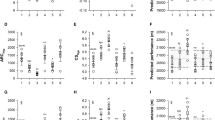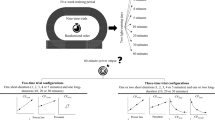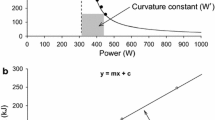Abstract
Competitive track cycling races are won by milliseconds, and the regulation of an athlete’s power output is an important factor in performance. The aim of this study was to use a mathematical model to predict finishing times for different pacing strategies for the individual pursuit (IP), to identify the optimal strategy in terms of fastest finishing time. Power profiles were generated for a number of common pacing strategies used in cycling, which were based on actual SRM power data for an elite, male, IP cyclist for whom the average power, maximum power, total work done and actual finishing time were known. The total work output was the same for all strategies and the finishing time was predicted using a mathematical model developed previously. The results showed that, of the strategies tested, an initial “all-out” high power acceleration phase followed by a lower constant power output produced the fastest finishing time for a 4,000 m IP event, and that the time spent in the initial high power acceleration phase had a significant effect on performance.





Similar content being viewed by others
References
Abbiss CR, Laursen PB (2008) Describing and understanding pacing strategies during athletic competition. Sports Med 38(3):239
Swain DP (1997) A model for optimizing cycling performance by varying power on hills and in wind. Med Sci Sports Exerc 29(8):1104
Atkinson G, Peacock O, Gibson ASC, Tucker R (2007) Distribution of power output during cycling: impact and mechanisms. Sports Med 37(8):647
Di Prampero PE, Cortili G, Mognoni P, Saibene F (1979) Equation of motion of a cyclist. J Appl Physiol 47(1):201
De Koning JJ, Bobbert MF, Foster C (1999) Determination of optimal pacing strategy in track cycling with an energy flow model. J Sci Med Sport 2(3):266–277
Van Ingen SGJ, Cavanagh PR (1990) Power equations in endurance sports. J Biomech 23(9):865
Underwood L, Jermy M (2010) Mathematical model of track cycling: the individual pursuit. Eng Sport 2(2):3217–3222
Wilson DG (2004) Bicycling science, 3rd edn. The MIT Press, London
Kyle CR, Bassett DR Jr (2003) The cycling world hour record. In: Burke ER (ed) High-tech cycling: the science of riding faster. Human Kinetics, Champaign, pp 175–196
Jermy M, Moore J, Bloomfield M (2008) Translational and rotational aerodynamic drag of composite construction bicycle wheels. Proc Inst Mech Eng P: J Sports Eng Technol 222(2):91–102
Martin JC, Gardner AS, Barras M, Martin DT (2006) Modelling sprint cycling using field-derived parameters and forward integration. Med Sci Sports Exerc 38(3):592
Atkinson G, Peacock O, Passfield L (2008) Variable versus constant power strategies during cycling time-trials: prediction of time savings using an up-to-date mathematical model. J Sports Sci 26(10):1123
Atkinson G, Brunskill A (2000) Pacing strategies during a cycling time trial with simulated headwinds and tailwinds. Ergonomics 43(10):1449–1460
Underwood L, Jermy M (2010) Mathematical modelling of track cycling: the individual pursuit. Procedia Eng 2:3217–3222
Acknowledgments
The authors would like to thank BikeNZ and SPARC for use of the athlete SRM power data for this study.
Ethical standard
Ethical approval was not required for this study as no testing was carried out on live subjects and only anonymised data was used.
Author information
Authors and Affiliations
Corresponding author
Appendices
Appendix 1
See Figs. 6, 7, 8, 9, 10, 11, 12, 13, 14 and 15.
Appendix 2
Athlete 1 | Athlete 2 | Athlete 3 | |||
|---|---|---|---|---|---|
Pacing strategy | Time (s) | Pacing strategy | Time (s) | Pacing strategy | Time (s) |
SRM | 222.063 | SRM | 220.228 | All-out 14 s and even | 272.182 |
All-out 14 s and variable (higher bends) | 221.795 | All-out 12 s and variable (higher bends) | 221.131 | All-out 12 s and even | 272.464 |
All-out 14 s and even | 221.958 | All-out 16 s and variable (higher bends) | 221.215 | SRM | 277.263 |
All-out 12 s and even | 222.033 | All-out 14 s and variable (higher bends) | 221.342 | All-out 16 s and variable (higher bends) | 282.171 |
All-out 10 s and variable (higher bends) | 222.163 | All-out 10 s and variable (higher bends) | 221.457 | All-out 12 s and variable (higher bends) | 282.201 |
All-out 10 s and even | 222.171 | All-out 10 s and even | 221.630 | All-out 14 s and variable (higher bends) | 282.205 |
All-out 16 s and even | 222.281 | All-out 12 s and variable (higher straights) | 221.739 | All-out 14 s and variable (higher straights) | 282.355 |
All-out 12 s and variable (higher bends) | 222.356 | All-out and linear decline (decline at 125 m) | 221.791 | All-out 12 s and variable (higher straights) | 282.37 |
All-out 12 s and variable (higher straights) | 222.445 | All-out 12 s and even | 221.815 | All-out 16 s and variable (higher straights) | 282.401 |
All-out 16 s and variable (higher bends) | 222.494 | All-out 16 s and variable (higher straights) | 222.025 | All-out 10 s and variable (higher straights) | 282.433 |
All-out 10 s and variable (higher straights) | 222.555 | All-out 16 s and even | 222.125 | All-out 16 s and even | 282.647 |
All-out 14 s and variable (higher straights) | 222.671 | All-out 14 s and variable (higher straights) | 222.285 | All-out 10 s and variable (higher bends) | 282.749 |
All-out 16 s and variable (higher straights) | 222.791 | All-out 14 s and even | 222.309 | All-out 10 s and even | 282.77 |
All-out and linear decline (decline at 125 m) | 223.641 | All-out 10 s and variable (higher straights) | 222.454 | Reverse J shaped | 285.193 |
Reverse J shaped | 223.713 | Reverse J shaped | 223.174 | Positive | 285.414 |
Positive | 224.24 | Positive | 223.719 | Even | 285.478 |
Variable higher bends | 224.531 | Even | 224.468 | Variable higher bends | 285.899 |
Variable higher straights | 224.582 | Variable higher bends | 225.009 | Variable higher straights | 285.993 |
Even | 225.09 | Variable higher straights | 225.043 | Negative (increase at 3,500 m) | 286.483 |
U shaped | 225.354 | Negative (increase at 3,500 m) | 226.243 | All-out and linear decline (decline at 125 m) | 287.409 |
Negative (increase at 3,500 m) | 226.099 | U shaped | 226.434 | U shaped | 287.487 |
J shaped | 227.306 | J shaped | 227.446 | J shaped | 288.897 |
Athlete 4 | Athlete 5 | Athlete 6 | |||
|---|---|---|---|---|---|
Pacing strategy | Time (s) | Pacing strategy | Time (s) | Pacing strategy | Time (s) |
All-out 16 s and variable (higher bends) | 262.935 | All-out 16 s and variable (higher straights) | 273.065 | SRM | 268.476 |
All-out 12 s and even | 263.44 | All-out 14 s and variable (higher bends) | 273.226 | All-out 14 s and variable (higher bends) | 276.175 |
All-out 14 s and variable (higher bends) | 263.44 | All-out 12 s and variable (higher bends) | 273.314 | All-out 12 s and variable (higher bends) | 276.204 |
All-out 14 s and even | 263.498 | All-out 14 s and variable (higher straights) | 273.36 | All-out 12 s and even | 276.292 |
All-out 12 s and variable (higher straights) | 263.536 | All-out 14 s and even | 273.372 | All-out 16 s and variable (higher bends) | 276.331 |
All-out 16 s and even | 263.543 | All-out 16 s and variable (higher bends) | 273.374 | All-out 16 s and even | 276.42 |
All-out 16 s and variable (higher straights) | 263.665 | All-out 12 s and even | 273.4 | All-out 14 s and variable (higher straights) | 276.454 |
All-out 14 s and variable (higher straights) | 263.672 | All-out 10 s and variable (higher bends) | 273.415 | All-out 16 s and variable (higher straights) | 276.518 |
SRM | 267.612 | All-out 10 s and even | 273.419 | All-out 14 s and even | 276.636 |
All-out 10 s and even | 263.996 | All-out 16 s and even | 273.469 | All-out 12 s and variable (higher straights) | 276.889 |
All-out 12 s and variable (higher bends) | 264.05 | All-out 12 s and variable (higher straights) | 273.499 | All-out 10 s and variable (higher bends) | 276.959 |
All-out 10 s and variable (higher bends) | 264.063 | SRM | 269.747 | All-out 10 s and even | 276.964 |
All-out 10 s and variable (higher straights) | 264.078 | All-out 10 s and variable (higher straights) | 273.789 | All-out 10 s and variable (higher straights) | 276.985 |
Reverse J shaped | 264.556 | Reverse J shaped | 274.822 | Reverse J shaped | 278.162 |
Positive | 265.371 | Positive | 275.129 | Positive | 278.44 |
Even | 266.189 | Variable higher bends | 276.04 | All-out and linear decline (decline at 125 m) | 278.978 |
Variable higher bends | 266.231 | Negative (increase at 3500 m) | 277.006 | Variable higher bends | 279.224 |
U shaped | 266.314 | Variable higher straights | 277.148 | Variable higher straights | 279.317 |
Variable higher straights | 266.504 | U shaped | 277.159 | Even | 279.828 |
Negative (increase at 3,500 m) | 266.659 | Even | 277.512 | Negative (increase at 3,500 m) | 279.828 |
J shaped | 268.074 | All-out and linear decline (decline at 125 m) | 280.624 | J shaped | 281.741 |
All-out and linear decline (decline at 125 m) | 271.236 | J shaped | 280.954 | U shaped | 297.709 |
Athlete 7 | |
|---|---|
Pacing strategy | Time (s) |
SRM | 264.887 |
All-out 12 s and even | 265.336 |
All-out 12 s and variable (higher bends) | 265.358 |
All-out 10 s and variable (higher bends) | 265.406 |
All-out 14 s and variable (higher bends) | 265.406 |
All-out 10 s and even | 265.421 |
All-out 14 s and even | 265.46 |
All-out 12 s and variable (higher straights) | 265.464 |
All-out 14 s and variable (higher straights) | 265.481 |
All-out 10 s and variable (higher straights) | 265.516 |
All-out 16 s and even | 265.582 |
All-out 16 s and variable (higher bends) | 265.606 |
All-out 16 s and variable (higher straights) | 265.642 |
All-out and linear decline (decline at 125 m) | 265.75 |
Reverse J shaped | 266.697 |
Positive | 267.731 |
Variable higher straights | 268.037 |
Even | 268.889 |
Variable higher bends | 269.807 |
Negative (increase at 3,500 m) | 270.627 |
J shaped | 270.767 |
U shaped | 271.929 |
Rights and permissions
About this article
Cite this article
Underwood, L., Jermy, M. Determining optimal pacing strategy for the track cycling individual pursuit event with a fixed energy mathematical model. Sports Eng 17, 183–196 (2014). https://doi.org/10.1007/s12283-014-0153-3
Published:
Issue Date:
DOI: https://doi.org/10.1007/s12283-014-0153-3














